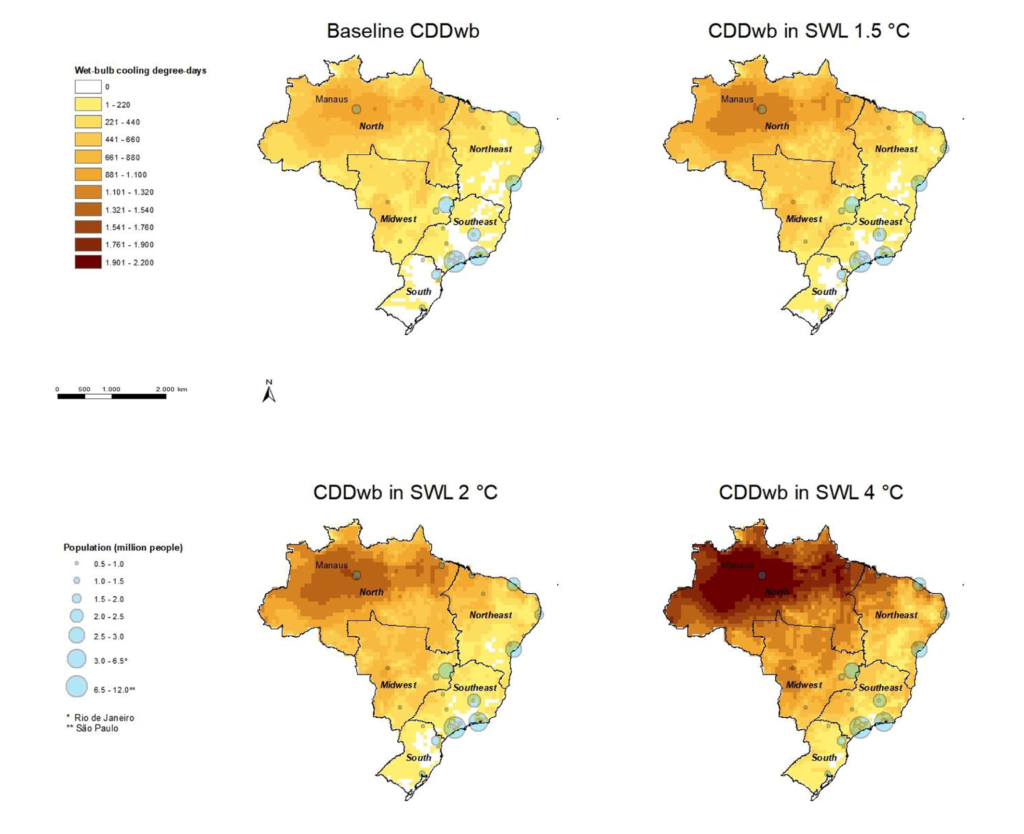
Increasing demand for space cooling in Brazil will increase greenhouse gas emissions by 70-190% due to air conditioners, depending on how much we will mitigate climate change. A study carried out with the contribution of CMCC@Ca’Foscari explains the relationship between climate change, space cooling needs, and electricity demand in different regions of the country.
Space cooling already accounts for 14% of residential electricity demand in Brazil, and it is expected to increase further because of climate change.
Very few studies investigate the relationship between climate change, cooling needs, and electricity demand. In a new study in Energy and Buildings, a team of researchers from Universidade Federal do Rio de Janeiro and CMCC@Ca’Foscari – a joint program of Ca’Foscari University of Venice and CMCC Foundation – investigate how climate and income during the period 1970-2010 shaped cooling services in Brazil. This historical relationship allows projecting the resulting energy demand for cooling services across three warming scenarios: +1.5°C, +2°C, +4°C.
The study shows that the average air conditioning equipment days of use would increase by more than 100% in Brazil, in a 4°C warming scenario. This would substantially impact the need for space cooling and consequently, the associated energy consumption. But even in the case of more optimistic future warming scenarios, energy consumption – and consequent emissions – will increase. Because of cooling needs, average CO2 emissions, today of 0.62 Mt per year, are projected to increase in the three warming scenarios respectively by 70% (+1.5°C), 99% (+2°C) and 190% (+4°C).
“To define past and future ambient thermal comfort needs we use the wet bulb Cooling Degree Days (CDDwb), a measure of temperature which accounts for air’s humidity” explains Enrica De Cian, Euro-Mediterranean Center on Climate Change and professor at Ca’ Foscari University of Venice, Department of Economics, co-author of the study and principal investigator of the ERC Starting Grant project ENERGYA – Energy use for Adaptation. “Brazil is a very peculiar country as it varies widely in climatic conditions and population density. Our study shows that the highest temperature growth will happen in the northern region, characterised by low population density. Therefore, it will not translate into relevant energy consumption, excepting for the city of Manaus, the seventh largest city of Brazil, which is in the North region of the country, at the center of the Amazon rainforest”.
The North is already saturated, with an average of 328 annual days of air conditioning use. On the opposite in the South region, a temperature increase of 4°C would inflate the energy consumption by almost 5 times.
Total energy demand for space cooling in the country may rise consistently because of the income effect alone, as it has been observed in the first decade of this century. “In addition to temperature and population density, income of a region is crucial in shaping energy demand” explains Malcolm Mistry, a researcher at CMCC Foundation and Ca’ Foscari University of Venice, Department of Economics. “Socio-economic drivers are also important to assess trends in ownership rates and types of air conditioning units in use, as typically there is a deficit in achieving thermal comfort in many Brazilian households because of budget constraints.”
Considering population and income increase alone, the ownership rate of space cooling appliances in Brazil can reach 96 air conditioning units per 100 households in 2035, compared to a current average of 40 units, boosting energy demand by 125%.
Energy efficiency can potentially reduce this growth in energy consumption observed for all warming scenarios. The potential carbon emissions avoided by energy savings from efficiency measures depends on the fuel mix of the power sector. In Brazil, the authors conclude, a 59% improvement of efficiency is feasible but it would require much more aggressive energy efficiency policies than those currently in place.

Annual wet-bulb Cooling Degree Days CDDwb (°C-days) in the baseline and the specific warming level scenarios
For more information:
Paula Bezerra, Fabioda Silva,Talita Cruza, Malcolm Mistry, Eveline Vasquez-Arroyo, Leticia Magalar, Enrica De Cian, André F. P. Lucena, Roberto Schaeffer, Impacts of a warmer world on space cooling demand in Brazilian households (2021), Energy and Buildings, https://doi.org/10.1016/j.enbuild.2020.110696


